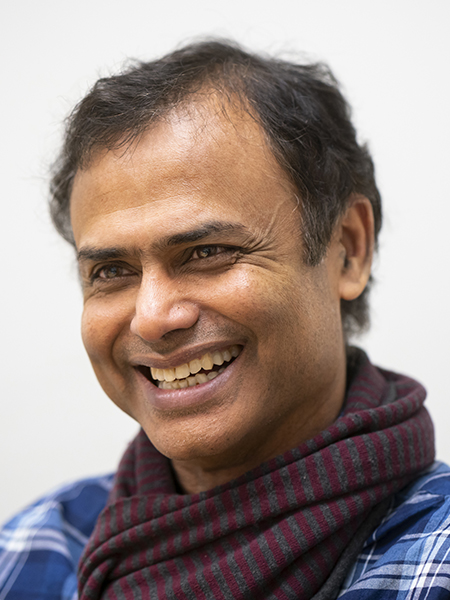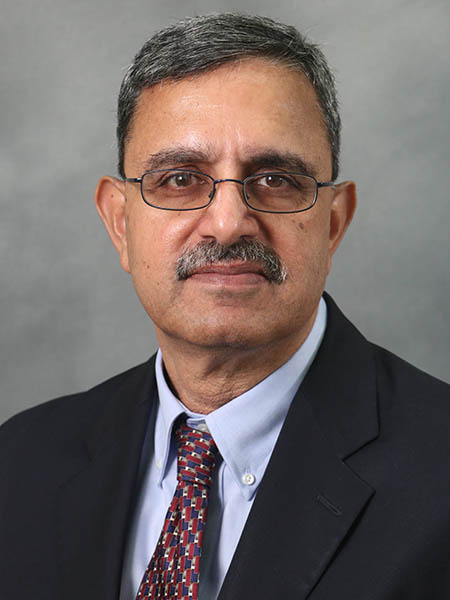ECE's Roy, ME's Subbarayan earn top awards from Semiconductor Research Corporation
Kaushik Roy, Edward G. Tiedemann Jr. Distinguished Professor of Electrical and Computer Engineering, and Ganesh Subbarayan, professor in the School of Mechanical Engineering, recently were honored with two of the Semiconductor Research Corporation’s most prestigious academic awards during its annual conference, TECHCON 2022, held Sept. 18-20 in Austin, Texas.

Roy received the Innovation Award, a new honor that recognizes patents and IP arising from Semiconductor Research Corporation (SRC) research that have made a significant impact on the semiconductor industry. He shares the award with alumnus Jaydeep Kulkarni (PhD ECE '09), who is now the Fellow of Silicon Labs Chair in Electrical Engineering at the University of Texas at Austin. During his PhD program at Purdue, Kulkarni explored ultra-low voltage integrated circuit design topics under Roy’s guidance.
“They successfully demonstrated a pioneering memory bitcell topology based on the Schmitt Trigger principle that can directly replace conventional 6 Transistor SRAM bitcell,” the SRC’s citation said. “This work described the principles of sub-threshold design very clearly, explained novel circuity techniques, and discussed the valuable design trade-offs.”
This research has influenced many subsequent designs and garnered 900 citations and two U.S. patents and was recognized with the Institute of Electrical and Electronics Engineers’ (IEEE) Transactions on VLSI Systems Best Paper Award in 2015. Read the full citation.
Subbarayan received the Technical Excellence Award, which was first presented in 1991 and recognizes key contributors of innovative technology that significantly enhance the productivity and competitiveness of the semiconductor industry.

Subbarayan’s award citation reads: “Dr. Ganesh Subbarayan of Purdue stands out as the top researcher for the comprehensiveness and rigor of his approach. He has combined the depth of Fracture & Continuum Mechanics with innovative computational and experimental techniques to describe solder material and stress evolution under different processing and reliability conditions and in the presence of multiple flaws.”
Subbarayan is the co-director of the SRC Center for Heterogeneous Integration Research in Packaging (CHIRP). His research is broadly focused on modeling and experimentally characterizing failure in microelectronic devices and assemblies. He was a pioneer in using geometric models directly for analysis, popularly referred to as isogeometric analysis. As an independent consultant, he contributed to ensuring reliable designs of Microsoft Kinect and the Surface line of products.
“Very distinguished Purdue researchers have received this award in the past, and I am humbled to have been selected this year,” Subbarayan said.
He is a recipient of the 2005 Mechanics Award from the American Society of Mechanical Engineers’ (ASME) Electronic and Photonic Packaging (EPP) Division and the National Science Foundation CAREER award. He is a fellow of ASME and IEEE, and he served as editor-in-chief of IEEE’s Transactions on Advanced Packaging during 2002-2010.
CHIRP’s goal is to enable cost-effective heterogeneously integrated systems of the future and to train engineers who will build these systems. Heterogeneous integration, which is the future of electronics packaging, involves stacking or arranging multiple chips close to each other into a single assembled unit to achieve performance, power density and area targets while keeping manufacturing costs low.
Since its inception in 2019, the center has undertaken funded projects totaling $6 million and completed four patent applications. CHIRP’s team includes 19 faculty researchers, 73 students and 66 industry mentors.
Roy is the director of the Center for Brain-inspired Computing Enabling Autonomous Intelligence (C-BRIC), a five-year project supported by $32 million in funding from DARPA/SRC via its Joint University Microelectronics Program. His research focuses on cognitive algorithms, circuits and architecture for energy-efficient neuromorphic computing/machine learning, and neuromimetic devices. He is the co-author of two books on Low Power CMOS VLSI design.
“I am deeply honored by the recognition of our patent by the SRC through this inaugural invention award,” Roy said.
A fellow of IEEE, Roy was named the 2021 recipient of the IEEE-CS TCVLSI Distinguished Research Award. He earned the National Science Foundation CAREER award. From the SRC, he has twice received the Inventors Award as well as the Technical Excellence Award.
C-BRIC’s mission is to deliver key advances in cognitive computing with the goal of enabling a new generation of autonomous intelligent systems, such as self-flying drones and interactive personal robots. The center’s research is organized into four themes: neuro-inspired algorithms, neuromorphic fabrics, distributed intelligence, and application drivers. The team comprises leaders from 10 universities.
